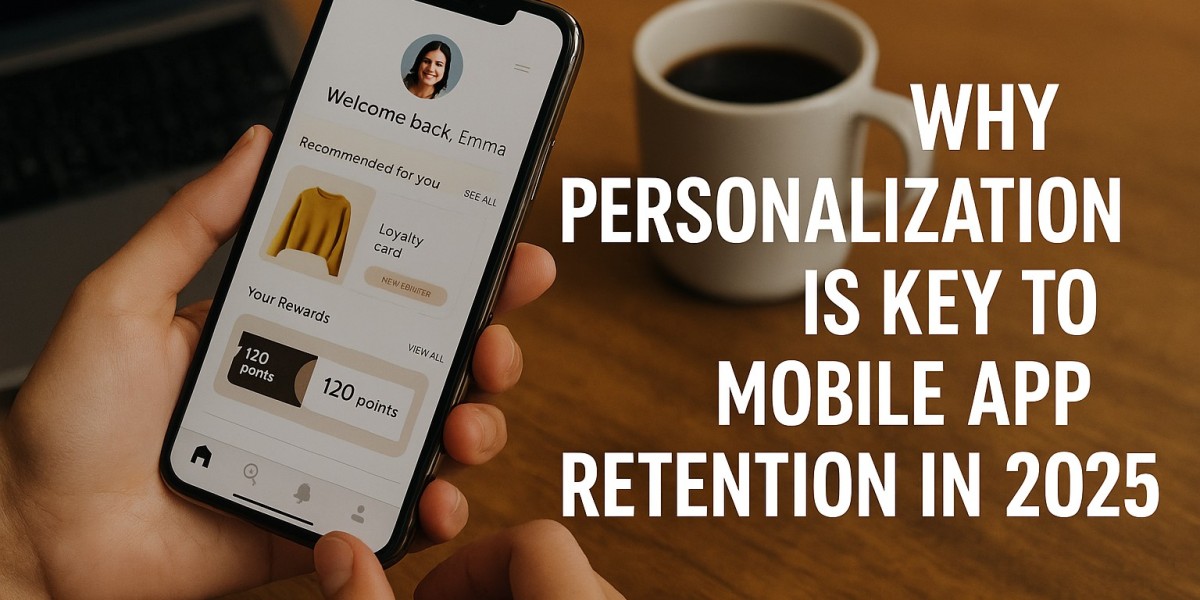The mobile app landscape in 2025 is more competitive than ever before. With hundreds of billions of downloads projected for the year, and an estimated 5,500 new apps hitting the market every single day, the challenge for developers and businesses is no longer just about acquiring users—it's about keeping them. In an environment where a significant portion of users uninstall an app after just one use, and the 30-day retention rate for most apps hovers in the single digits, generic, one-size-fits-all experiences are a guaranteed path to obscurity.
The key to survival and success in this saturated market is personalization. Moving beyond simple first-name greetings and basic product recommendations, the personalization of 2025 is a sophisticated, data-driven, and hyper-intelligent approach that makes every user feel seen, understood, and valued. For a forward-thinking Mobile App Development Company, mastering this art is no longer a competitive advantage—it is a fundamental requirement for creating a successful, sticky, and profitable application. This article will delve into the critical role of personalization in driving mobile app retention, exploring the technologies that make it possible and the strategies that define it.
The Retention Crisis: A Look at the 2025 Mobile Landscape
The statistics paint a stark picture. Users have an average of 60 to 90 apps installed on their phones, but they only use a handful daily. A staggering one in four users deletes an app after a single use, and only a tiny fraction—around 3%—of apps manage to retain active users after 30 days. This "retention crisis" is driven by a number of factors, most notably the poor user experience that many apps deliver. Users are quick to abandon apps that are buggy, have a clunky interface, or, most critically, feel irrelevant to their lives.
In this context, the goal of a Mobile App Development Company must shift from simply launching a functional app to crafting an essential one. An essential app is not just a tool; it's an experience that integrates seamlessly into a user’s daily routine, adapts to their needs, and anticipates their next move. This level of intimacy and relevance is the direct result of a well-executed personalization strategy.
The Foundation of Modern Personalization: AI and Machine Learning
The hyper-personalization we see in 2025 is powered by the rapid evolution of Artificial Intelligence (AI) and Machine Learning (ML). These technologies have moved beyond being futuristic concepts to become the backbone of modern app experiences. They enable apps to move from reactive to proactive, understanding and predicting user behavior with remarkable accuracy.
Here’s how AI and ML are fueling the personalization revolution:
Predictive Recommendations: This is the most common form of AI personalization. Platforms like Netflix and Spotify have long set the standard, using ML algorithms to analyze a user’s consumption history, search queries, and even the time of day to suggest content they are highly likely to enjoy. In 2025, this extends to nearly every app category, from e-commerce apps suggesting products based on a user's browsing patterns to health and fitness apps recommending workouts based on past performance and goals.
Dynamic UI/UX Adaptation: No two users are the same, and their app interface shouldn't be either. AI allows an app's UI and UX to adapt in real-time. This can be as simple as an e-commerce app highlighting categories a user frequently browses or as complex as a financial app re-arranging its dashboard to show a user's most-used tools first. This dynamic adaptation makes the app feel intuitive and effortless, reducing friction and encouraging longer sessions.
Contextual Personalization: The most advanced form of personalization takes a user's real-world context into account. AI and ML algorithms can leverage data points like a user's geographic location, the time of day, and even the weather to provide hyper-relevant experiences. A coffee ordering app might automatically surface the nearest café's menu as a user approaches a store, while a news app could prioritize local stories in the morning. This "right place, right time" approach is a game-changer for engagement and convenience.
Natural Language Processing (NLP): With the rise of voice-driven interfaces and sophisticated chatbots, NLP is key to making personalization feel more human. AI-powered chatbots can understand user intent, answer complex queries, and provide personalized support, freeing up human agents for more complex issues. This not only improves the user experience but also provides a continuous feedback loop for gathering more data to refine personalization.
A Mobile App Development Company that understands and leverages these technologies is well-positioned to build an app that doesn't just retain users but turns them into loyal advocates.
The Pillars of a Successful Personalization Strategy
Building a personalized app isn't just about integrating AI; it's about a holistic strategy that touches every aspect of the user journey. The most effective personalization is built on a few core pillars:
1. Data Collection and Analysis
Data is the fuel for personalization. A successful app strategy begins with the responsible collection and meticulous analysis of user data. This includes:
Behavioral Data: How a user interacts with the app (clicks, swipes, search history, session duration).
Demographic Data: User-provided information (age, location, gender).
Contextual Data: Real-time information like location, time of day, and device type.
Transactional Data: Purchase history, in-app purchases, and subscriptions.
A Mobile App Development Company must implement robust analytics frameworks from day one to collect this data and transform it into actionable insights.
2. Personalized Onboarding
First impressions are everything. The onboarding process is the user's first real interaction with an app, and a personalized onboarding can make the difference between retention and immediate churn. Instead of a generic, multi-step tutorial, a personalized onboarding flow adapts to the user's role, goals, and device. For a fitness app, this might mean asking a user if they are a beginner or an expert and then tailoring the initial dashboard to show relevant content. This makes the user feel like the app was built specifically for them, setting a positive tone for future engagement.
3. Hyper-Targeted Push Notifications
The traditional push notification—a generic blast sent to all users—is dead. In 2025, it’s seen as a nuisance, a primary driver of app uninstalls. Modern personalization transforms push notifications into helpful, timely nudges. They are based on user behavior, time zones, and specific interests. An e-commerce app might send a notification about a flash sale on a brand the user has previously browsed. A travel app could send an alert about flight delays, or a news app could send a breaking story alert relevant to the user's city. This level of relevance is what turns an annoying interruption into a valuable service.
4. Cross-Platform Consistency
Today’s users move seamlessly between devices—from their phone to their tablet to their desktop. A personalized experience must be consistent across all these touchpoints. An app must remember a user's preferences, browsing history, and progress, ensuring that a user doesn't have to start over every time they switch devices. For a streaming service, this means a user can start a movie on their phone during their commute and pick up exactly where they left off on their smart TV at home. A sophisticated Mobile App Development Company ensures this seamless journey is a core part of its development process.
Real-World Examples of Personalization in Action (2025)
To understand the power of personalization, let's look at how successful apps across different industries are implementing it:
E-commerce: A major retail app uses AI to create a dynamic homepage for each user. It features recently viewed items, product recommendations based on past purchases and browsing history, and tailored promotions for brands the user follows. This has led to a 30% increase in conversion rates and a significant boost in monthly active users.
Media & Entertainment: A popular video-streaming platform has completely personalized its homepage, eliminating the "top 10" list and replacing it with a "For You" section that features a mix of new releases and classic titles based on a user's viewing habits, even adjusting based on the time of day (e.g., suggesting a short comedy in the morning and a long-form drama at night).
Finance: A mobile banking app uses ML to analyze a user's spending patterns and provide hyper-personalized insights. It sends notifications like "You've spent 25% more on coffee this month than last," or "You have enough saved to book that trip you were looking at." This turns a purely transactional app into a valuable financial wellness tool, dramatically improving user engagement and trust.
The Role of a Mobile App Development Company
The shift to a personalization-first mindset requires a fundamental change in how apps are conceived, designed, and built. This is where a skilled Mobile App Development Company becomes an indispensable partner. Their role extends far beyond just writing code.
Strategic Consulting: A great development company works as a strategic partner, helping clients understand the immense value of personalization. They help identify key user segments, define personalization goals, and create a data strategy that aligns with business objectives.
AI/ML Expertise: Building the sophisticated algorithms needed for modern personalization requires specialized expertise. A leading Mobile App Development Company has a team of data scientists and machine learning engineers who can design, train, and deploy models that power predictive recommendations, dynamic interfaces, and contextual targeting.
Secure and Ethical Data Handling: Personalization relies on sensitive user data, making privacy and security paramount. A reputable development company adheres to all relevant data protection regulations (like GDPR and the India's DPDP Act) and builds apps with security-first architecture, ensuring user data is protected and handled with complete transparency.
Iterative Development and A/B Testing: Personalization is an ongoing process, not a one-time feature. A good development company will build a system for continuous A/B testing and analysis, allowing for the constant refinement of personalization strategies based on real-world user feedback and performance metrics.
The Future: Hyper-Personalization and Beyond
Looking beyond 2025, the future of mobile app personalization is even more exciting. The trend is moving towards hyper-personalization, where apps will anticipate a user’s needs before they even know them.
Proactive Apps: Apps will use a combination of data points to offer services before a user asks. A travel app might send a notification about a hotel deal in a city a user has a flight to, or a ride-sharing app might prompt a user to book a ride for a flight it detects they have.
Emotion-Aware Experiences: Advancements in AI could allow apps to detect a user's mood or stress levels through behavioral cues and adapt accordingly. A mindfulness app might suggest a specific guided meditation if it senses a user is stressed, or a media app could adjust its content mix to be more upbeat.
AR/VR and Personalization: The integration of Augmented and Virtual Reality will open up new frontiers. A shopping app might use AR to allow a user to virtually try on clothing or see how a piece of furniture looks in their home, with the suggestions for these items being entirely personalized based on their style and preferences.
In this rapidly evolving digital ecosystem, personalization is no longer a luxury—it’s the cornerstone of a sustainable business model. For any business looking to build a mobile app that stands out from the crowd, partnering with a Mobile App Development Company that prioritizes this human-centric, data-driven approach is the single most important decision they can make. It is the key to not only acquiring users but to building a loyal and engaged community that will stand the test of time.













